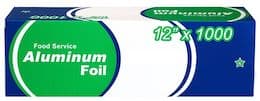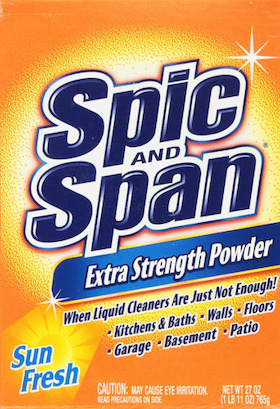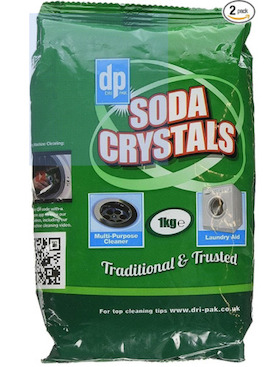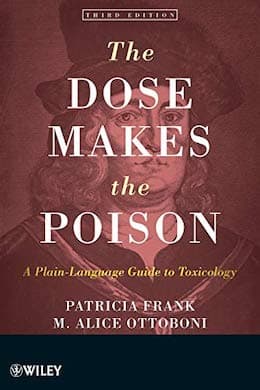
Curated with aloha by
Ted Mooney, P.E. RET

The authoritative public forum
for Metal Finishing 1989-2025

-----
Remove silver tarnish with aluminum foil
Quickstart:
Tarnish can be quickly removed by placing the silver on aluminum foil in a bath of hot water & any conductive "salt" (baking soda, washing soda, Spin 'n Span) in a non-metallic dishpan. Whereas silver polish removes the silver sulfide tarnish -- with a bit of silver lost each time -- this method electrochemically converts the silver sulfide back to silver with no loss.
![]() I used boiling water, a recycled piece of aluminum in a ceramic bowl, 1 cup baking soda, 1 tsp salt. Added as much jewelry as would all fit on the aluminum. In less than 15 minutes the water was brown, the silver was clean.
I used boiling water, a recycled piece of aluminum in a ceramic bowl, 1 cup baking soda, 1 tsp salt. Added as much jewelry as would all fit on the aluminum. In less than 15 minutes the water was brown, the silver was clean.
- San Rafael, California
April 14, 2024
⇩ Related postings, oldest first ⇩
Q. I've heard of a way of cleaning silver using aluminum foil, boiling water and baking soda [in bulk on
eBay
or
Amazon [affil links]
. Does this work?
Thanks,
1998
A. Hi Louis. I've done it for myself and it worked well; my wife has done it several times. And from numerous successful reports on thread 4785, "Polishing Silver with Aluminum Foil and Baking Soda", it's worked well for lots of people! Good luck with it, or read on for some specific hints.
Regards,

Ted Mooney, P.E.
Striving to live Aloha
finishing.com - Pine Beach, New Jersey
A. I just tried the Al, baking soda on a silver US quarter, Nothing much happened.
"420 Ways to Clean Everything" by Harriet Wylie ⇦[this on
AbeBooks
or eBay or
Amazon affil links]
, says to use Al foil, kosher salt
⇦ this on
eBay
or
Amazon [affil links]
, and cold water and to dip the cutlery for 2 minutes to remove stubborn stains. That seemed to loosen the black coating on the quarter, but you still have to brush it.

Tom Pullizzi
Falls Township, Pennsylvania
A. My ideas for best success with this technique:
1). - the conversion of the tarnish back to silver depends on conducting electricity, not on whether the dissolved "salt" is baking soda, kosher salt, washing soda, water softener salt, or trisodium phosphate -- you can use anything you have that will conduct electricity well.
2). - but all chemical reactions occur much faster at high temperatures.
3). - the word "cleaning" is imprecise. The reaction we're talking about is not about removing ground in finger oils and dirt, but about electrochemically converting silver tarnish back to silver. Still, removing that oil & dirt is necessary, especially on decades-old quarters, and baking soda or kosher salt in water is a poor detergent :-)
So to me, the best way to help the reaction occur fast & easy, and leave any scum easily wiped off, if you're dealing with old stuff that is dirty as well as tarnished, is probably to use a TSP-based detergent like Spic and Span ⇦ this on eBay or Amazon [affil links] and very hot water. The hot water and strong detergent, however, will mean you'd probably want to wear dishwashing gloves ⇦ this on eBay or Amazon [affil links] .
Regards,

Ted Mooney, P.E.
Striving to live Aloha
finishing.com - Pine Beach, New Jersey
Q. Louis,
Exactly how are you supposed to use the aluminum foil, baking soda and hot water?
Ralph B [last name deleted for privacy by Editor]1998
 I have heard of the Aluminum, salt and water method for silver. It is actually supposed to reverse the tarnishing process. The salt water acting as the electrolyte between the two nodes. I have tried it myself, both with cold and boiling water, but with no success.
I have heard of the Aluminum, salt and water method for silver. It is actually supposed to reverse the tarnishing process. The salt water acting as the electrolyte between the two nodes. I have tried it myself, both with cold and boiling water, but with no success.
- West Plains, Missouri
A. Hi Louis, hi Ralph: Thread 4785 discusses it in great depth and boring detail, but it's really not tricky and nothing is critical. Put a piece of aluminum foil on the bottom of anything non-metallic; mix a generous amount of baking soda [in bulk on
eBay
or
Amazon [affil links]
, washing soda
⇦ this on
eBay
or
Amazon [affil links]
, or my favorite, Spic and Span
⇦ this on
eBay or
Amazon [affil links]
into hot water, and pour it in. Drop your silver onto the foil, and that's it.
Hi Kelly: Are you sure that your silver is touching the aluminum foil? (it needs to). Might you be working with silver jewelry that has a non-conductive lacquer clearcoat on it?
Regards,

Ted Mooney, P.E.
Striving to live Aloha
finishing.com - Pine Beach, New Jersey
A. With respect to tarnishing of silver, if it's like copper you're getting a corrosion film of the sulfur compounds as well as some oxide and/or carbonate.
I have used the aluminum process, except with baking soda rather than NaCl, with some success. It electrolytically reverses much of the tarnish, and a faint sulfide smell is noted. It didn't work as well as on the TV where the miracle plate of aluminum ($0.25 worth of aluminum, sold for $20!) was used. I tried both scrap aluminum and aluminum foil - the silver must be electrically in GOOD contact with the aluminum, by the way. I suspect that experimenting with different grades of aluminum alloys in waters of differing hardnesses would account for many of the results listed above. Higher temperature water seemed to have a very limited accelerating effect, maybe excluding oxygen by boiling is an important step?
Silver naturally will tarnish in the atmosphere, with a huge dependence on the presence of sulfur. Eggs, industrial atmospheres, and natural digestive processes are probably the important sources for most fine silver. Like brass, you can put on a high quality lacquer finish immediately after cleaning to shield the metal, but silverware and other implements will probably suffer damaged coatings in use. Hope these ramblings are of assistance.

Paul Tibbals, P.E.
gas & electric
San Ramon, California, USA
(My opinions are not related to nor a statement of my employer's)
A. With respect to cleaning silver using aluminum --
Perhaps it will work better if you abrade the surface of the aluminum that contacts the silver. Oxide coating may act as insulator.
James Chunn- Theodore, Alabama
A. If you don't want to fool with all the mess, foil, salt, boiling water, buy a Silver Cleaning Plate ⇦ this on eBay or Amazon [affil links] . They really do work, I've been using one for over 8 years. Simple and easy, no mess no fuss. I love silver and have lots of it.
Thanks, Sue
Sue R [last name deleted for privacy by Editor]- York, South Carolina
1999
![]() I just did all my silver using WARM water, Al foil and table salt. I poured the salt directly onto the foil, then mixed it a little to dissolve it in the water. Then the silver was placed DIRECTLY onto the foil (shiny side up). It took about 3 min to clean the entire teapot. Try it, it really works!
I just did all my silver using WARM water, Al foil and table salt. I poured the salt directly onto the foil, then mixed it a little to dissolve it in the water. Then the silver was placed DIRECTLY onto the foil (shiny side up). It took about 3 min to clean the entire teapot. Try it, it really works!
A. I find that aluminum foil, boiling water and baking soda only works if you put it in a plastic dish - I use a rectangular shallow dish. If you put it in metal the reaction will not occur. Hope this helps; also rinse the silver in hot soapy water and dry immediately.
Carla L [last name deleted for privacy by Editor]- london, Ontario, Canada
2000
Multiple threads merged: please forgive chronology errors and repetition 🙂
Q. A friend of mine has this metal plate that she puts in the sink with some water softener salt ⇦ this on eBay or Amazon [affil links] and puts her silver in it. It cleans beautifully and fast. They use to sell it on T.V. Now I can't find it. Does anyone know where I can get this metal plate?
Thanks.
Micheline Fioriti- Montreal, Canada
2001
A. Here are links to buy a cleaning plate, but some people say aluminum foil works just as good, Micheline :-)

Ted Mooney, P.E.
Striving to live Aloha
finishing.com - Pine Beach, New Jersey
A. I have used several metal cleaning plates. The safest, and one I like best, can be purchased from a company named Special Metal Cleaners, Inc. It is guaranteed never to wear out and is especially safe for precious jewelry as well as antique silver.
Erin N [last name deleted for privacy by Editor]- Fairmont Nebraska
Ed. note: For a discussion of commercial cleaning plates in lieu of aluminum foil, please see threads: 14623 and 34314.
A. I saw, on TV, a method to remove tarnish from silver, It DID utilize water, aluminum foil and salt, but it did NOT utilize baking soda. Instead of baking soda, it utilized powdered water softener salt ⇦ this on eBay or Amazon [affil links] .

Glenwood Reed
- Mechanicsburg, Pennsylvania
2003
A. I saw this on Mr. Wizard as a child, from then on it was my job to clean my mom's silver. Use baking soda, salt, hot water and a piece of aluminum foil in the solution. The tarnish should come right off; the foil is there to give the tarnish something to bind to so it won't collect onto the next piece you clean. It's been a while but it worked like a charm then.
William B [last name deleted for privacy by Editor]- Phoenix, Arizona
Q. I notice you were in charge of the silver cleaning in your house. Do you have the combination of products for the non tarnishing of silver. I know I should use: aluminum foil, salt, baking powder or water softener salt ⇦ this on eBay or Amazon [affil links] and water. But how much of each?
Thanks,
M A Coudry- Tacoma, Washington
A. A great fast way to clean silver that is very intricate and hard to clean is....take a aluminum pie dish...put hot water in it add a cup of water softener and a splash of vinegar ⇦in bulk on eBay or Amazon [affil links] dip your silver in and pull out. comes out spotless.
Tara Copper- Canada
2004
A. For the water softener, get Arm and Hammer Super washing soda ⇦ this on eBay or Amazon [affil links] (NOT baking soda). I put a silver coin in a plastic dish that I lined with aluminum foil, covered it with the washing soda, then put some boiling water on top. It fizzed a little and smelled like sulfur. The coin had to be wiped off gently when removed and it was shiny and new!
Bob U. [last name deleted for privacy by Editor]- Laurel, Maryland
Multiple threads merged: please forgive chronology errors and repetition 🙂
Q. Dear Helper,
I am in year 10 at St Pius X College Chatswood. At present I have an assessment task for science which requires me to carry out a scientific investigation. I chose to research and report on a method of cleaning tarnished silverware. The method involves submerging silver items into a bowl lined with aluminum and filled with boiling water and a teaspoon of salt (dissolved). (no baking soda) I have found that the salt is only a catalyst, as the silver and aluminium combo works as well. I am writing this e-mail to ask you if you could explain the process that is occurring and provide me with an equation (words and symbols) Thank you for taking the time to read my posting.
Yours sincerely,
I am sorry if this is inconvenient but I really need a reply.
Please help me.
Patrick R [last name deleted for privacy by Editor]- Sydney, NSW, Australia
2004
A. The principle behind this is that most metals corrode with exposure to oxygen. For example, iron rusts with time because of its exposure to moisture in the air, oxygen. You may also have noticed that cars in the northeast rust a lot faster because of the salt used on the roads in winter. The whole process involves electrons moving between the metal and oxygen atoms. It happens spontaneously with most metals (gold being a notable exception). Silver does pretty much the same thing, only that tarnish is the combination of silver with sulfur ⇦ this on eBay or Amazon [affil links] and not oxygen. Silver is special with its more complex reactions, but the principle by which silver tarnishes is the same by which iron rusts.
Aluminum also does the same thing, only it happens more readily than silver...(see where this is going?)
So we need to move the electrons to and from the metals and we need a metal that will take the electrochemical abuse for the silver. The aluminum takes the hit for the silver, and the salt water allows the electrons to move between the silver and aluminum. I would explain more, but this is not a general chemistry article.
This of course raises the question of why airplanes (which have aluminum) don't dissolve in mid flight...
Lisa Robbinson- NSW, Australia
A. Explanation: Silver tarnishes because it undergoes a chemical reaction with sulfur-containing substances in the air. Silver combines with sulfur to form silver sulfide, which is black, and darkens the silver.The silver can be made shiny again by removing the silver sulfide coating from the surface.
Two ways to remove the silver sulfide are to: remove it from the surface, or reverse the chemical reaction and turn silver sulfide back into silver. The first method involves polishes that remove some of the silver during polishing. The above demo uses a chemical reaction (which is sped up by heating the water) to convert the silver sulfide back into silver, without removing any silver.
Aluminum has a lower ionization energy (energy required to remove electrons from an atom of the element) than silver. As a result, aluminum is oxidized (loses electrons and oxidation number increases), and silver is reduced (gains electrons and oxidation number is reduced). Depending on the amount of tarnish, the silver will be bright and the aluminum foil may be brown with tarnish (aluminum oxide), in a short while. The silver tarnish is "transferred" to the aluminum via reactions, which occur instantaneously, as follows:
3Ag2S(s) + 2Al(s)+ 3H2O(l) => 6Ag(s) + Al2O3(s) + 3H2S(aq)
silver sulfide + aluminum + water => silver + aluminum oxide + hydrogen sulfide
(* Note, this reaction can be done without the baking soda, but it takes longer to see results).
The baking soda (sodium bicarbonate) reacts with the (sulfur-smelling) H2S:
3 NaHCO3(aq) + 3 H2S(aq) => 3 NaHS(aq)+3 H2O(l)+ 3 CO2(g)
baking soda + hydrogen sulfide => sodium hydrosulfide + water + carbon dioxide. The CO2 gas can be observed escaping from the most tarnished parts of the silver.
The silver and aluminum must be in contact with each other because a small electric current flows between them during the reaction.This type of reaction, which involves an electric current (because atoms are charged), is called an electrochemical reaction, and is used in batteries to produce electricity.
Tania R. Chase- Topsham, Maine
Q. I can understand Tania from Maine's equation from my schoolboy chemistry, and it's exactly what I wanted to know.
What I don't understand are the letters in parentheses next to each compound.
Why baking soda? Does it convert the gas from hydrogen sulfide to carbon dioxide -- hydrogen sulfide is poisonous.
david haynes- wantage,oxon,uk
A. Hi, David.
Tania is apparently indicating whether the compounds are solids, liquids, gases, or ionized in an aqueous solution.
Baking soda merely supplies conductivity. Similar results can be had with washing soda ⇦ this on eBay or Amazon [affil links] , Spic and Span ⇦ this on eBay or Amazon [affil links] , or other conductive salts. Although hydrogen sulfide is poisonous, Paracelsus reminded us that everything is poison; it's all in the dose. Eggs release hydrogen sulfide as well.
Regards,

Ted Mooney, P.E.
Striving to live Aloha
finishing.com - Pine Beach, New Jersey
Q. Tania, I do believe you got the reaction correct. Very nice explanation! However, I don't think the silver needs to be in contact with the aluminum because the saltwater acts as an electrolyte.
Susan Ammons- Bowling Green, Kentucky
January 10, 2009
A. Hi. The silver does need to be in contact with the aluminum. For silver sulfide to be reduced to silver, electrons must flow to it from the aluminum, and there needs to be metal-to-metal contact so the electrons can flow. Ions flow through the liquid, but electrons flow through metal.
Regards,

Ted Mooney, P.E.
Striving to live Aloha
finishing.com - Pine Beach, New Jersey
!! Hello,
Believe it or not, white chalk powder both cleans and prevents silver from tarnishing. Store silver in a zip lock bag with a little chalk dust. It works on both fine and sterling silver.
- East Meadow, New York, America
2005
A. One cheap and easy way I have found to remove tarnish from silver is to use regular toothpaste, not the gel type, just regular paste type. Just rub it on or use an old toothbrush, especially when cleaning intricate parts, like jewelry. Then rinse and dry. No harsh chemicals to harm pearls or other delicate stones.
Dian Holmes- Graceville, Florida, USA
July 11, 2009
A. I did the experiment. If you put 500 ml of water, 7.5 ml of baking soda and 2.5 ml of salt in a GLASS pot with aluminum foil covering the inside on the stove on high let it sit. Right before it starts to boil cut it off, put in the silver or the forks and let them sit for 1 minute then take them out and wipe off.
It Works.
- Jacksonville, Florida
2007
Q. I put aluminium foil on the base of the pot and tore bit off in the water poured a fair bit of light salt all over wondering if light salt is the problem?
rhys liebigamateur - townsville, Qld, Australia
2007
A. I doubt that the salt is the problem, although most people recommend washing soda ⇦ this on eBay or Amazon [affil links] rather than salt.
The silver may be lacquered, which would prevent the action from happening, or your procedure may be wrong. Unfortunately, I can't understand what you are saying about your procedure, but it's very simple: The silver must touch the aluminum foil and the silver must be fully immersed.

Ted Mooney, P.E.
Striving to live Aloha
finishing.com - Pine Beach, New Jersey
![]() I read the articles on how to get rid of tarnish because I have a ring holder that is all silver and shaped like a swan. My swan was extremely tarnished, and I mixed together two of the ways to get rid of the tarnish because none of them worked by themselves. I boiled water with salt, and then I poured baking soda all over my swan. I got the baking powder wet with the salty water so that it was damp, and then I scrubbed it with tin foil. The tarnish came off easily, I wish I figured this out thirty minutes before when I started my project!
I read the articles on how to get rid of tarnish because I have a ring holder that is all silver and shaped like a swan. My swan was extremely tarnished, and I mixed together two of the ways to get rid of the tarnish because none of them worked by themselves. I boiled water with salt, and then I poured baking soda all over my swan. I got the baking powder wet with the salty water so that it was damp, and then I scrubbed it with tin foil. The tarnish came off easily, I wish I figured this out thirty minutes before when I started my project!
- New York City, New York, United States
Multiple threads merged: please forgive chronology errors and repetition 🙂
Q. Should the aluminium foil be shiny side up or dull side up?
SHIV ANAND- Houston, Texas
2006
A. The aluminum foil should be bright side up.
Robert Franklin Kynor- Newburyport, Massachusetts
A. Hi Shiv,
I don't think it makes any difference. The difference in appearance is only because of how it has to be made. To make foil two sheets of aluminum must be placed together then rolled down to thinness. The outsides which rub on the rolls gets shiny. The sides where the two pieces of foil are touching each other remain matte in appearance.
Luck & Regards,

Ted Mooney, P.E. RET
Striving to live Aloha
finishing.com - Pine Beach, New Jersey
Q. It appears that foil with salt works, somewhat. Thanks for your help.
What do you suggest I do to bring a sparkle to serving trays? Some are larger than the sinks.
- Burnaby, BC, Canada
March 5, 2009
A. Hi, Rod. There is no end to the size of containers. Bathtubs or stoppered shower areas can accommodate rather large trays. But I have heard, without personally verifying it, that scrubbing the tray with the aluminum foil wetted with the washing soda ⇦ this on eBay or Amazon [affil links] will work. Good luck.
Regards,

Ted Mooney, P.E.
Striving to live Aloha
finishing.com - Pine Beach, New Jersey
Q. Can I use the above method for silver with freshwater pearls jewelry as well? Or, do I have to wrap the pearls separately with aluminium foil first before submerging the piece of jewelry in the solution?
Thanks!
Anne Smith
Designer - Chicago, Illinois
March 6, 2009
A. Pearls should only be cleaned with a good quality pearl cleaner
barbara fein
- Los Angeles, California
Q. About the optimum Water, Salt, Soda, and Foil amounts. I would assume that both Water and Foil are bulk for the reaction, meaning that as long you have enough present, the amount doesn't matter (too much doesn't hurt)
Salt being the conductor (when dissolved) is dependent on the amount of water you use. More Water requires more Salt.
Soda deals with the Sulfur from the Silver so I would assume you only need so much, based on the amount of Silver (and the amount/years of tarnish on it)
I see so many "recipes" around that only have Salt to Soda ratios 1:1, and 1:2 is common, but there are others like 1:12 and 1:24~48 these don't relate to how much Water you have at all. A cup, a pan, and a bathtub worth of Water really do need different amounts of Salt.
Long ago when I first heard of this (pre-internet) it was to add Salt until it doesn't dissolve (a few crystals sit on the bottom and persist). This method adds Salt dependent on the amount of Water. I think it was 2 Tbsp of Soda for a Silver set (8 settings), this adds Soda, based on the Tarnish (Silver).
A Setting is commonly 1 knife, 1 fork, 1 spoon, 1 Salad fork, 1 soup spoon, and the set pieces 1/8 Butter Knife, 1/8 Serving fork, 1/8 Serving Spoon, 1/8 Pickle Fork. So 5-1/2 (~6) tableware pieces per-seat gives a ratio of
Water:salt
1:Saturation
Tarnish:Soda
1 piece:1/8 tsp
So here is the question,
Is there a better Water:Salt Tarnish:Soda ratio that make sense?
- Ludington, Michigan USA
August 7, 2010
Q. Can the chemical reaction be sped up by adding additional electrical current (connect battery to the 'soup')?
Mike Lowe- San Diego, California, USA
November 23, 2010
A. Hi. Some people say the reaction is instantaneous in hot to boiling water anyway.
Sure, external electrical power can be used to drive an electrochemical reaction ... it's done in electroplating and other processes ... but it makes a simple reaction more complicated :-(
Regards,

Ted Mooney, P.E.
Striving to live Aloha
finishing.com - Pine Beach, New Jersey
Q. Dear chemistry interested
I was wondering, if there exists a similar technique for cleaning brass or bronze items?
Sincerly yours
Soren, brass artist
- Haderslev, Danmark
November 15, 2014
A. Hi Soren. To my knowledge, brass and bronze don't become sulfided like silver, so the reactions would be different. I believe that copper "bright dips" can be used on brass and bronze. The bright dips are comprised of an acid and an oxidizing agent. Nitric acid is one example, sulfuric acid plus hydrogen peroxide is another. But here we're talking about materials that are far more dangerous and less suitable for home use than aluminum foil and washing soda ⇦ this on eBay or Amazon [affil links] . Good luck.
Regards,

Ted Mooney, P.E.
Striving to live Aloha
finishing.com - Pine Beach, New Jersey
A. For the large serving trays, scrubbing with aluminum foil works for me. For my jewelry, I use an old toothbrush with foil wrapped around the handle end. Use the brush end to soak crevices with solution, then gently scrub with the foiled handle. When possible, I do this with the item IN the solution.
My formula is 1 cup near-boiling water with 1 T each salt, soda, and liquid dish detergent.
I'm no chemist, but when cooking, baking soda can be substituted with baking powder and salt. Both soda and salt may create a reaction with the foil, but they are also mild abrasives, and therefor excellent for cleaning. You can make an inexpensive scouring powder with equal parts coarse salt, baking soda, and borax
⇦ this on
eBay
or
Amazon [affil links]
. (Works wonders on ceramic stove tops.)
For cleaning brass or bronze, try this formula. I use this solution for my bathroom cleaner and it?s simply amazing. Just spray, let sit a few minutes, wipe and rinse. Soap scum, hard water build up, and any kind of "crusties" will start to disappear in just a few days; and it leaves your fixtures bright and shiny. For gunked-up shower heads, just spray and leave. We've also used this for burnt pans, grill grates, car bumpers, and all kinds of outside surfaces.
1 c. white vinegar
⇦in bulk on
eBay
or
Amazon [affil links] (dissolves soap scum)
2 T borax (scouring agent)
2 T lemon or lime juice (polishes/makes shiny)
1/4 tsp. bleach
⇦ bleach/sodium hypochlorite in bulk on
eBay
or
Amazon [affil links]
(cleans/disinfects surfaces)
1 c. water
- LaGrange, Kentucky, USA
November 29, 2014
Q. I have a large punch bowl. I used the plate. It said put salt on it. I rotated the bowl around the plate. It said I will need to do this several times. 2 questions. Can I immerse the punch bowl or do all the surfaces that need to be cleaned have to touch the plate? Also it said to clean pour vinegar on it and scrub with an abrasive pad. It must be shiny and clean. I scrubbed it, but I'm not sure if it is clean. I see darker spots, patches on the plate. I did not rinse the plate as the instructions just said pour vinegar and scrub. Please advise. Thank you.
Leslie bacon- Altus, Oklahoma USA
December 1, 2017
A. Hi Leslie. You should lay the plate under the punch bowl, with the bowl fully submerged in a large plastic dishpan or a fiberglass or Corian sink (not a conductive metal sink). I can't countermand the instructions that came with the cleaning plate, but I'm sure you're supposed to rinse it. Good luck.
Regards,

Ted Mooney, P.E. RET
Striving to live Aloha
finishing.com - Pine Beach, New Jersey
Q. Would an aluminium saucepan work as well as aluminium foil to clean silver?
Corinna Hattonretired - Bexhill, East Sussex, UK
December 15, 2017
![]() I just tried the boiling water/baking soda/aluminum foil method. It does work. My silver bracelet looks great. Thank you for the advice.
I just tried the boiling water/baking soda/aluminum foil method. It does work. My silver bracelet looks great. Thank you for the advice.
K-
- Warwick, Bermuda
January 27, 2009
A. I read through this site and didn't have baking soda and salt was taking too long. So I asked someone and she said try ashes. So I did and it worked at first try.
Sammy Foster- NYC, New York
Q. Does anyone know what is the cloudy surface layer that can sometimes form or appear on sterling silver after cleaning with commercial Silver Dip (Thio-urea/sulfuric acid/Detergent mixtures)?
I sort of think that it is a salt of silver, but it is lightfast, does not seem to be soluble in dilute Ammonia, or in either Tartaric or citric acid
⇦ this on
eBay
or
Amazon [affil links] solutions.
Of course it might not even be a silver salt.
Quite a puzzle.
- Melbourne, Victoria, Australia
June 3, 2013
|
A. You probably etched the surface slightly. A little bit of buffing should brighten your items. Neil BellAlbuquerque, New Mexico A. Hi Robert  Geoff Smith Hampshire, England |
Q, A, or Comment on THIS thread -or- Start a NEW Thread




